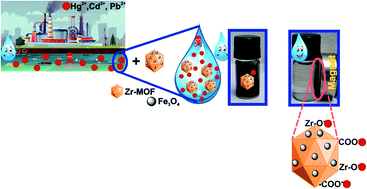Magnetic MOF-808 as a novel adsorbent for toxic metal removal from aqueous solutions†
Abstract
Mercury (Hg) in water is a global concern due to its high toxicity and bioaccumulation in the food chain, which severely affects the environment and human health. In this work, a magnetic zirconium metal–organic framework (Zr-MOF@Fe3O4) has been synthesized for Hg(II) removal. The Zr-MOF@Fe3O4 demonstrated the maximum adsorption capacity of 303 mg g−1 at pH 6. The possible mechanism was confirmed by spectroscopic analysis, which indicated that free –COOH groups and Zr–OH were responsible for adsorption. The adsorbent showed high uptake capacity for Hg(II), Pb(II), and Cd(II) ions in a multi-element solution. The regeneration of the material was successfully carried out with NaOH solution for five cycles. Thus, the study has reported a highly efficient adsorbent for the removal of toxic heavy metals from aqueous solutions.

- This article is part of the themed collections: Celebrating Latin American Chemistry and Topic Collection: Wastewater Treatment


 Please wait while we load your content...
Please wait while we load your content...